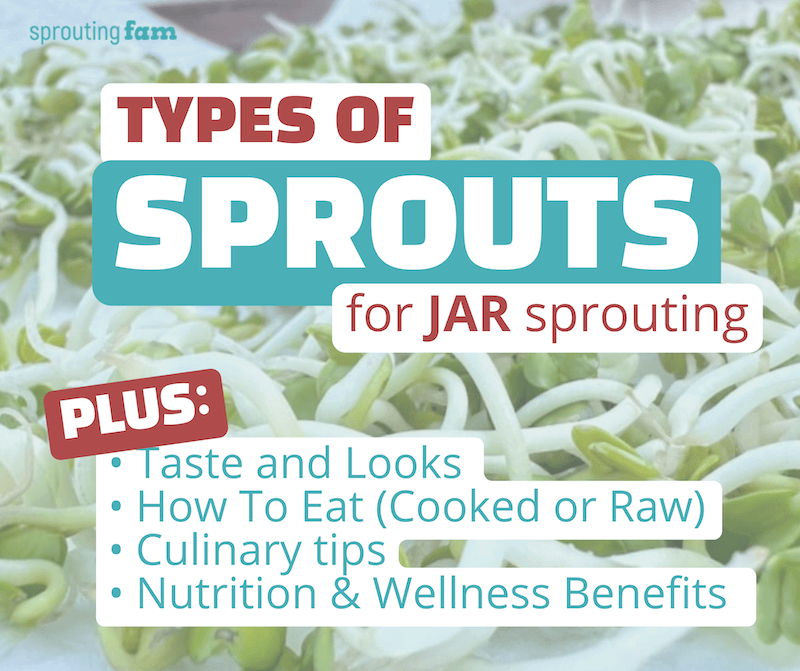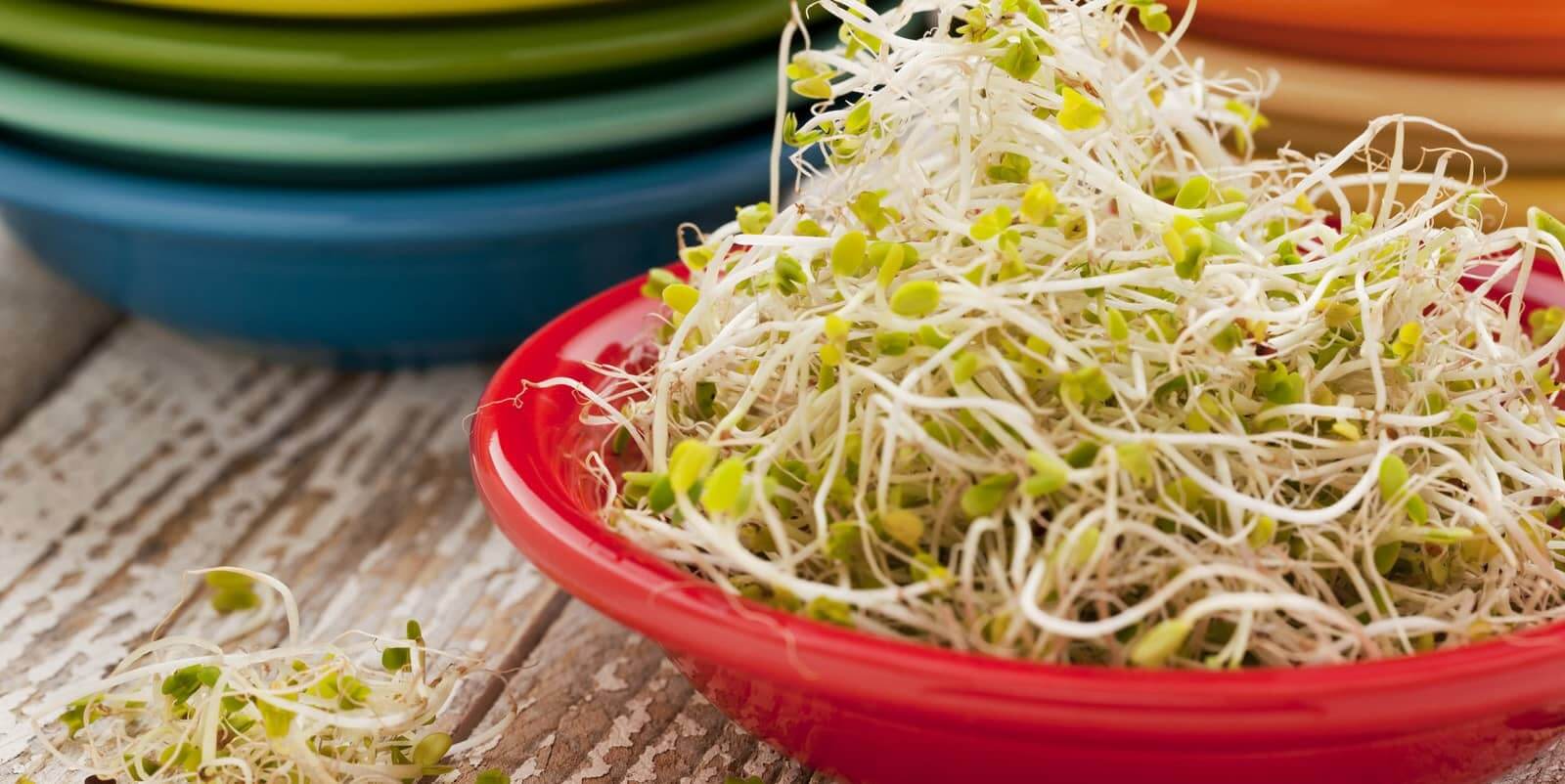Sproutingfam.com is supported by its readers. If you purchase through a link on my site, I may earn a commission. Learn more
The Best Types Of Sprouts For Home Jar Sprouting – 36+ Sprout Varieties
Looking for the best types of sprouts for specific situations?
In this guide I share all the different sprouts you can grow at home in mason jars.
In order to catalog all the edible sprouting seeds to sprout, I made this list of the best types of sprouts for growing in jars at home.
The list ended up at 8 different sprout types all excellent for jar sprouting: cruciferous, sunflower, legumes, grains, alfalfa, red clover, pumpkin seeds, buckwheat groats.
And then over 36 individual sprout types. These include alfalfa, sunflower, clover, arugula, lettuce, spinach, Swiss chard, dill.
Lastly, I’ve sorted them by their nutrients or how they’re used i.e. great for cooking, for eating raw, for sandwiches, for soups.

What Is Jar Sprouting?
Jar sprouting is a simple method that lets you grow flavorful, nutrient-rich sprouts indoors at home using glass jars (with ease and year round, too).
This type of indoor food growing has become popular in recent years due to the many benefits of consuming high energy sprouts.
With convenient sprouting kits available, the extreme ease of sprouting, and these many different nutritious types of sprouting seeds we have at our disposal, it’s not surprising.
And for those without potential access to fresh greens, jar sprouting (and other forms of sprouting) has become far more than a popular fad. It’s become a godsend.
Many types of sprouts don’t even require sunlight.
For example, radish sprouts just need indirect sunlight. You don’t need direct sunshine to grow radish sprouts.

8 Of The Best Types Of Sprouts For Jar Sprouting
After these 8 sprout types, I list out the list of 36+ individual great sprouts to grow.
Onto the best types of sprouts for home jar sprouting.
Starting off with the #1 superfood sprout type, cruciferous sprouts.
1. Cruciferous Sprouts

Cruciferous sprouts are excellent jar sprouters across the board. Cruciferous plants come from the Brassicaceae family (a.k.a. the mustard family), a family of vegetables known for their wide range of nutrient and flavor profiles. Thus, their sprouts are absolutely packed with nutrients.
- Looks: Tiny or small, thin stems and leaves, usually green (unless radish).
- Taste: Peppery to earthy, cruciferous sprout types offer a full range of flavors.
- How To Eat: Raw or cooked.
- Nutrition/Wellness: phytonutrients, vitamins, minerals, antioxidants, sulforaphane.
- Culinary: If cooking, great sautéed or steamed.
Why Cruciferous Sprouts Grow So Great In Mason Jars
Jar sprouting makes growing cruciferous sprouts easy. Their seeds germinate quickly, with most usually ready to harvest by day 5. Commonly sprouted cruciferous seeds include:
- Broccoli
- Radish
- Kale
- Cabbage
- Mustard
The Most Nutritious Sprouts You Can Grow
Cruciferous broccoli sprouts are considered the Holy Grail of superfood sprouts. But did you know that all cruciferous sprouts have sulforaphane and high levels of nutrients special to cruciferous sprouts as well? Some even would grow radish sprouts BEFORE broccoli as the healthiest types of sprouts.
Don’t like broccoli?
If broccoli sprouts are not your thing, you can still get the beneficial compounds they’re known for. Obtain their nutrients by sprouting other cruciferous sprouts. From mustard to kale to radish, all cruciferous sprouts provide their own unique yet similar set of powerful cruciferous-sprout nutrients.
Also The Most Flavorful Sprouts!
Alongside their signature high levels of sulforaphane is their wide range flavors. From bitter to spicy, cruciferous sprouts will hit more taste buds than any other type of sprout on this list. For example, spare the chili flakes or hot sauce and go for radish sprouts next time you need to add a kick to your salad or sandwich.
2. Red Clover Sprouts

All clover sprouts are great for jar sprouting. There are over 300 species of clover, and many others are said to be tasty and great for sprouting too. The clover flowering plant is a legume (from legume family Fabaceae). Red Clover sprouts are similar in looks and taste to alfalfa sprouts.
- Taste: Their earthy flavor is stronger than alfalfa sprouts, but they taste and feel similar in texture.
- How To Eat: Enjoyed most eaten raw.
- Wellness: Notably high amounts of isoflavones (a phytoestrogen).
- Culinary: Great added to sandwiches and eggs.
3. Sunflower Sprouts
Sunflower seeds grow great when jar sprouting. A joy to eat raw, sunflower sprouts add a fresh and highly-nutritious nutty crunch to recipes when added to them raw.
Taste-wise, you can call it a lesser sunflower seed taste, but with added juiciness. They’re so good that your finished sunflower sprouts may not ever make it to a plate…
Sunflower Sprout Quick Hits:
- Looks: Long, thick stem that expands with 2 green loopy leaves.
- Taste: Sunflowers’ massive flowers give us seeds that jar sprout into what I often think are truly the most delicious sprouts.
- How To Eat: Raw or lightly cooked/sautéed.
- Nutrition/Wellness: Vitamin E, minerals, antioxidants, protein, more.
- Culinary: Use as salad base or garnish.
- Sprouting: An easy seed to sprout in jars. Take around a week.
Super Sunflower Snack: If you love snacking on de-hulled sunflower seeds, try a double sunflower sprout bowl: Just mix sunflower seeds together with freshly jar sprouted sunflower sprouts, and then eat them together.
Note on Jar Sprouting Sunflower Seeds: Because they’re so big, drain sunflower seeds extra thoroughly to prevent mold growth when jar sprouting.
4. Legume Sprouts

Beans beans,
The musical fruit.
The more you eat,
The more you toot.
Unless that is,
They were sprout-ed.
If you can make is rhyme in a rhythm to the -ed from “sprout-ed”, then awesome you can make these additional final 2 lines work.
The sprouting process negates the anti-nutrients in legumes such as lectins or phytic acid. Sprouting legumes before consuming them is better because their complex carbs get broken down, leaving you without the gassy and bloaty side effects.
Some types of legumes to jar sprout:
- Mung Beans
- Garbanzo Beans (chickpea sprouts)
- Lentils
- Clover
- Peas
All types of legume sprouts can be grown inside of glass jars. While trays may be their ideal method for being grown, it seems jars are just as good if you’re doing it properly.
As far as what legume sprouts offer, you’ll find many similarities across all legume sprout types because they all come from the same botanical family.
All the different legume sprouts have some similarities:
- Taste: All legume sprouts are a bit nutty or “earthy.”
- How To Eat: All can be eaten raw or cooked. Perfect for stir fries.
- Nutrition: Protein rich, high in fiber, vitamin C, B’s, minerals incl. iron, magnesium, potassium.
- Culinary: A joy to add to salads and sandwiches raw due to their delightful crunch.
- Sprouting time: Short germination time, quick to sprout, perfect for home jar sprouting.
5. Grain Sprouts

Grain sprouts and mason jars go hand in hand. All types of grain sprouts can grow to perfection within mason jars. Grain sprouts have good essential vitamins and minerals, they taste earthy, and are great grain alternative for any bread-making and baking.
You can jar sprout grains of all types:
- Wheat berry – from common wheat species Triticum spp.
- Quinoa – pseudocereal from Chenopodium quinoa plant.
- Barley – from Hordeum vulgare.
- Rye – from secale cereale.
- Millet – from small seed grass plants within the Paoceae family.
- Spelt* – a wheat from Triticum spelta, part of the ancient wheat category.
Sproutpeople has a good video on how to sprout grains. This is where I learned.
Bonus: Ancient Wheat Grain Sprout Types
If you can access ancient wheat seeds, ancient grains have a richer set of nutrients compared to today’s. What’s that mean for ancient wheat sprouts? The best part is, you can find ancient wheat sprouting seeds online with ease (locally might be a bit more difficult).
Here are 4 ancient wheats (the only ones I know of) to find sprouting seeds for:
- Einkorn (Triticum monococcum)
- Emmer (Triticum dicoccum)
- Spelt (Triticum spelta)
- Kamut (Khorasan wheat)
6. Alfalfa Sprouts

Alfalfa sprouts grow perfect in wide mouth glass mason jars with stainless steel sprouting lids. Similar to sunflower sprouts, nutrient-packed alfalfa are a joy to grow and eat, making them a perfect for making glass jar sprouting a family activity. Your children can more easily enjoy their finished product with these.
- Taste: Sweet and nutty, but mild (mild taste and crunch).
- How To Eat: Raw is best.
- Wellness: phytoestrogens, antioxidants, vitamins A,C,K, calcium, iron and other minerals.
- Culinary: Great for sandwhiches and salads for the added freshness and crunch (the nutrients too).
Alfalfa sprouts blend well with things and won’t overpower your recipes like radish sprouts or other more powerful sprouts would, even when not used in excess.
7. Pumpkin Seed Sprouts

Pumpkin seed sprouts come out excellent when jar sprouted. It’s a top method for sprouting pumpkin seeds.
Pumpkin seed sprouts have excellent nutrients that are more bioavailable when sprouted. The germination process creates a phytic acid break down process that helps you avoid the anti-nutrients unsprouted pumpkin seeds contain.
- Taste: Signature pumpkin seed taste. Sweet, nutty.
- How To Eat: Eat raw or cooked.
- Nutrition/Wellness: Copper, micronutrients, protein, fat, zinc, magnesium, phosphorus, potassium, and manganese and other minerals, plus benefits for men, specifically.
- Culinary: Great in smoothies, yogurt, sandwiches, salads.
It’s a no brainer to sprout pumpkin seeds! Once you know, you know!
8. Buckwheat Sprouts

Buckwheat sprouts come from the seeds of the Buckwheat plant (binomial Fagopyrum esculentum). They get their own spot on this list because their seeds look and act like a grain, so they’re often on grain lists, but they’re not grain sprouts.
Buckwheat is a “pseudocereal,” – a non-grass plant that produces grain-like seeds. True cereal grains only come from a grass plants in the Poaceae family.
Pseuodocereal sprouts sound just as good as wheat sprouts.
- Taste: Earthy, tart, fresh.
- How To Eat: Raw or lightly cooked.
- Looks: Small green leaves on shorter, thin white stems.
- Nutrition/Wellness: bioflavanoid-rich, antioxidants, vitamin C, essential amino acids, more.
- Culinary Use: Tartness complements sweet dishes, add fresh to salads, sandwiches, smoothies.
While true cereals offer their own unique benefits, pseudocereals (quinoa is another) are known to have a better nutritional profile. I left quinoa under the grain sprout type above, but after I experience sprouting quinoa, I may end up giving it its own Types of Sprouts list placement as well.
SPROUTING GUIDE: How To Sprout Buckwheat Groats (& Why You Should)
36+ Different Sprouts Perfect For Home Jar Sprouting
I’ve placed many types of sprouts into categories based on what their key nutrient offered is if they have one, how they’re best eaten (raw or cooked), top culinary usages, etc.
All sprout types below are great jar sprouters.
Sprouts Known For Their Nutrients
Best Sprouts for Protein
- Mung bean sprouts
- Lentil sprouts
- Chickpea sprouts
- Kidney bean
- Soybean sprouts
- Green lentil sprouts
- Pea shoots
- Garbanzo bean sprouts
Nutrient-Rich Sprouts
All of these sprouts have a good amount of vitamin C as well as other vitamins, minerals, phytonutrients or beneficial compounds.
- Broccoli – sulforaphane
- Red cabbage – vitamin C
- Radish sprouts (both white and red varieties are similarly nutrient-rich)
- Pea shoots – protein
- Mustard seed – vitamin C
- Red clover – vitamin C
Culinary-Focused Sprouts
Sprouts For Asian and Mediterranean Cuisine Recipes
If you’re in the mood for delicious Asian food cooking, the following sprout types would all enhance your Asian-inspired recipes:
- Bean sprouts
- Mungbeans
- Soybeans
- Greenpea sprouts
And then if you’re into one of arguably the best types of cuisines there is, Mediterranean, then grow the following sprouts for adding to your Mediterranean-inspired meals:
- Garbanzo (Chickpea)
- Lentil sprouts
- Fenugreek
- Arugula (Rucola)
- Sesame seed
Best Types Of Sprouts For Cooking
All these sprouts, especially bean and lentil sprouts, are great for cooking and can be worked into many dishes that don’t normally have sprouts. Other recipes are reliant on these cookable sprout types.
From flavors to nutrients, here’s a list of types of sprouts great for cooking:
- Bean
- Corn
- Broccoli
- Pea shoots
- Green Pea sprouts
- Mung bean
- Mustard plant
- Wheat sprouts (note: ALL grain sprouts are said to cook well)
- Lentil sprouts (I know that garbanzo sprouts cook great)
- Red Adzuki sprouts
- Sesame seed sprouts
Best Sprouts For Salads
Sunflower sprouts can be a salad base? Actual lettuce sprouts are a must-add salad ingredient?
There’s what seems to be an endless amount of flavorful sprout types well suited to salads.. each containing a unique, proper crunch. Like a finger print or snowflake design. Each of these types of sprouts for salads will perfect your next salad recipe in its own, unique way.
The following sprout types enhance salads and sandwiches (smoothies too!):
- Alfalfa
- Sunflower
- Red Clover
- Arugula
- Clover
- Lettuce
- Spinach
- Swiss Chard
- Romaine
- Parsley
- Cilantro
- Dill
- Mizuna
- Onion
Smoothie Sprouts
You can’t go wrong when using these sprouts in your smoothies:
- Wheat
- Sunflower
- Pea Shoots
- Broccoli
- Pumpkin Seed
Best Sprouts To Eat Raw
The following list gives you more ideas for sprouting if you’re looking to grow sprouts for raw-eating enjoyment.
- Sunflower
- Radish (only if you really love spiciness!)
- Alfalfa
- Clover
- Rucola
- Leek
- Chia
Sunflower sprouts are my #1 for raw eating. Alfalfa is good too. But radish? If you can handle spice, you’ll be one of the few able to enjoy the sweetness that’s very noticeable at first, before the mouthful of raw radish-sprout-spice kicks in.
Best Sprouts To Grow As A Family Activity
Sprouting’s an excellent learning activity for children of all ages. Legumes are one of the best but there are many other great easy-to-grow types of sprouts you can eat raw to grow with your children.
Some of the easiest sprouts to grow:
- Sunflower – easy and delicious. A great first sprout.
- Alfalfa – also one of the easiest sprouts to grow.
- Chickpea – one of the best for kids to learn with.
- Lentil – another easy sprout you can’t go wrong with.
- Radish – easy too o grow, but not easy to eat for little ones.
- Quinoa – have a unique look to them.
- Wheat – also fun to watch grow.
Summary
Thanks for making it down to here. That’s a lot of great potential growing there in these sprout types shared in this article. First the 8 types of sprouts:
- Cruciferous
- Sunflower
- Legume
- Grain
- Alfalfa
- Red Clover
- Pumpkin seeds
- Buckwheat
Then the list of 36+ individual sprouts. These I put into lists, separated by their key feature or use, including which sprouts are high in protein, vitamin C, great for salads, for cooking, for eating raw, etc.
If you’re looking for different types of sprouts to grow, I hope this list of different sprouts helps you.
Let me know if you have any questions or comments about these sprout types I have chosen to start home sprouting with.
Thanks again for coming by the Sprouting Fam blog!

Sources
- Superfood Evolution: Growing Super Sprouts, Types of Sprouts and Their Benefits. From https://www.superfoodevolution.com/super-sprouts.html
- FoodPrint: Real Food – Sprouts. From https://foodprint.org/real-food/sprouts/
- The Nutritional and Medicinal Value of Sprouts. From https://www.ncbi.nlm.nih.gov/pmc/articles/PMCPMC-related-article
- Health Benefits of Cruciferous Sprouts. From https://www.healthline.com/nutrition/cruciferous-sprouts
- Seeds For Growing Sprouts – https://www.gardeningknowhow.com/garden-how-to/propagation/seeds/seeds-for-growing-sprouts.htm
Next: How To Sterilize Mason Jars & Lids For Sprouting – Best & Worst Methods







Thank you! Love these overview posts
Much appreciate this compliment, Rick. Thank You!